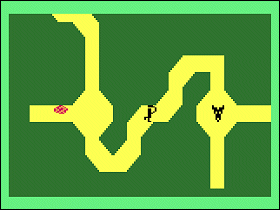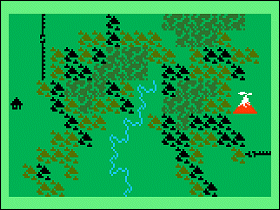 The Game: Your quest begins as you set out from the safety of home to look for adventure in mountainous caverns. When you wander into the dungeons and caverns, your view zooms in to the maze your adventurer is exploring, complete with treasures to collect and deadly dangers to duel. (Mattel Electronics, 1982)
The Game: Your quest begins as you set out from the safety of home to look for adventure in mountainous caverns. When you wander into the dungeons and caverns, your view zooms in to the maze your adventurer is exploring, complete with treasures to collect and deadly dangers to duel. (Mattel Electronics, 1982)
Memories: Combining sword-and-sorcery – traditionally the territory of paper-and-dice role playing games – with video game action has been one of the more inspired mash-ups to come from the golden age of video games. As combinations go, it was almost inevitable – with Dungeons & Dragons being more geeky than mainstream in the 1970s, it was an activity with which game programmers – another geeky crowd – were likely to be acquainted. With all of that crossover going on, it was therefore inevitable that someone, presumably whoever had deep enough pockets to license the title and game elements, would eventually produce an official video game.
The beauty of the first Advanced Dungeons & Dragons game for the Intellivision is that it really does play, more or less, like a computer-moderated session of the real thing, trading atmosphere and descriptions for fast action. The abundance of dice-rolling is compressed into arcade-style action out of necessity, but the visual presentation looks very  much like some poor player character’s top-down map of recently explored territory, complete with darkness enveloping portions of the
much like some poor player character’s top-down map of recently explored territory, complete with darkness enveloping portions of the  maze that have yet to be revealed. The graphics are simple and succinct, and the control scheme is as intuitive as it possibly can be with the Intellivision keypad (using the same “move with the disc, shoot with the keypad” scheme as Tron Deadly Discs).
maze that have yet to be revealed. The graphics are simple and succinct, and the control scheme is as intuitive as it possibly can be with the Intellivision keypad (using the same “move with the disc, shoot with the keypad” scheme as Tron Deadly Discs).
Despite this, for whatever reason, the next game in the series abandoned the interface of this first AD&D cartridge (and in case you’re wondering, the word “Cartridge” is indeed part of the game’s official, formal title, as specified in the contract between Mattel Electronics and TSR). The next time Mattel revisited AD&D, it was with a sometimes clumsy first-person perspective that didn’t improve the game; by the time a third game was in the works – with a back-to-basics look – Mattel Electronics was on the verge of being closed down, a major victim of the video game industry crash. (That third game was eventually released with no D&D connecions, or licensing, as Tower Of Doom.) Mattel also milked the D&D license for a handheld game with an LCD screen.
 D&D and AD&D have gone on to become major video and computer gaming franchises, but the marriage between the venerable granddaddy of role playing games and one of the original game consoles begins here – and it’s still fun if you’re not necessarily looking for all of the complexities that most people think of when paper-and-dice RPGs are mentioned.
D&D and AD&D have gone on to become major video and computer gaming franchises, but the marriage between the venerable granddaddy of role playing games and one of the original game consoles begins here – and it’s still fun if you’re not necessarily looking for all of the complexities that most people think of when paper-and-dice RPGs are mentioned.